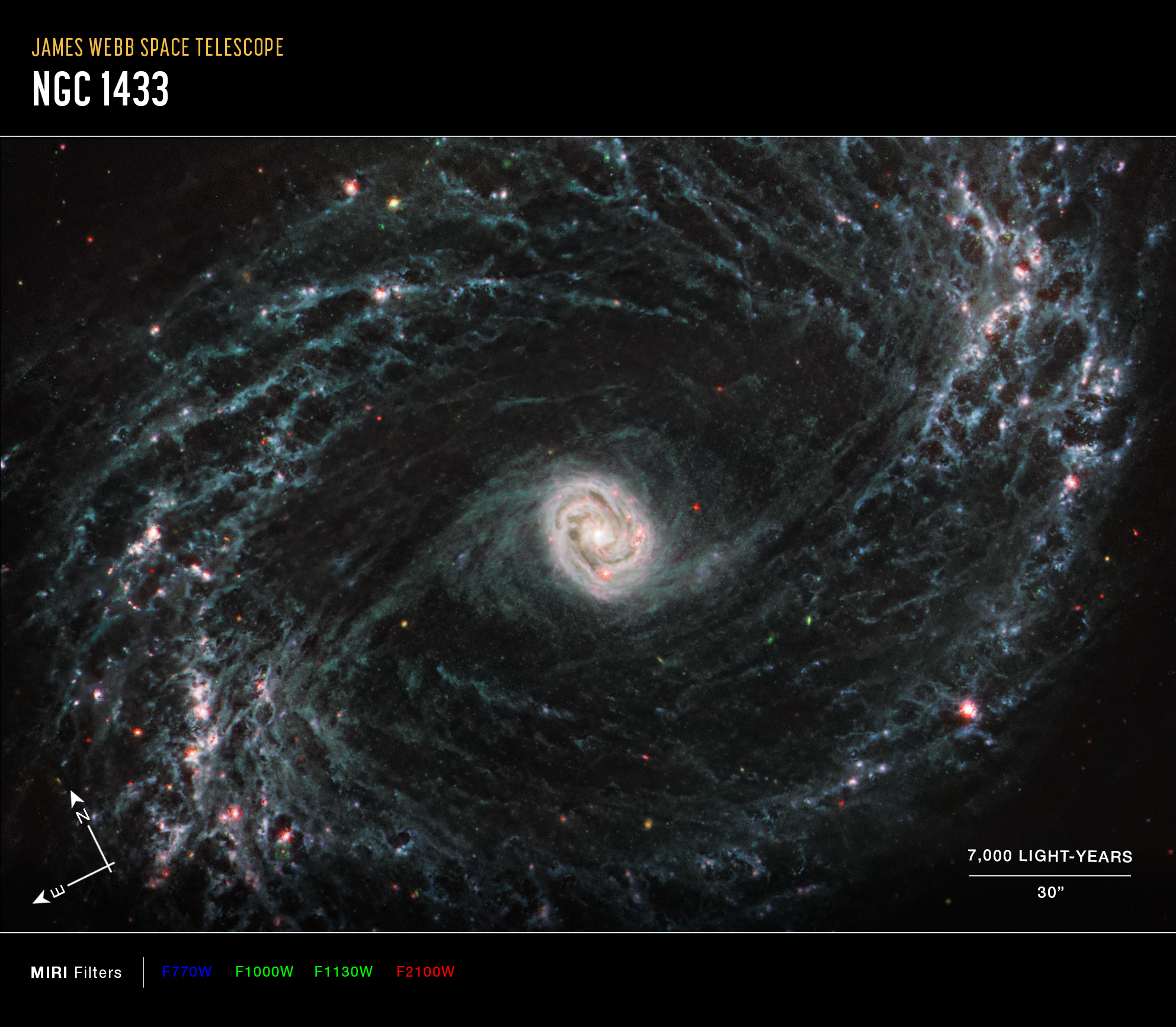James Webb Space Telescope spies baby stars dancing in swirling gas and dust (photos)
Researchers can now see the influence of young stars on galaxy formation.
The James Webb Space Telescope (JWST) is still doing its job — and doing it very well. Released today, this image shows the arms of barred spiral galaxy NGC 1433 teeming with young stars that can be seen affecting the clouds of gas and dust around them. The image was taken as part of the Physics at High Angular resolution in Nearby Galaxies (PHANGS) collaboration, of which more than 100 researchers around the world are a part.
One of the James Webb Space Telescope's first science programs is to image 19 spiral galaxies for PHANGS with its Mid-Infrared Instrument (MIRI), which is capable of seeing through gas and dust clouds that are impenetrable with other types of imaging.
"The PHANGS team has spent years observing these galaxies at optical, radio, and ultraviolet wavelengths using NASA's Hubble Space Telescope, the Atacama Large Millimeter/Submillimeter Array, and the Very Large Telescope's Multi Unit Spectroscopic Explorer," PHANGS team member Adam Leroy of the Ohio State University said in a statement. "But, the earliest stages of a star's lifecycle have remained out of view because the process is enshrouded within gas and dust clouds."
Related: James Webb Space Telescope's best images of all time

In the MIRI observations of NGC 1365, clumps of dust and gas in the interstellar medium have absorbed the light from forming stars and emitted it back out in the infrared, lighting up an intricate network of cavernous bubbles and filamentary shells created by young stars releasing energy into the galaxy's spiral arms.

At the center of NGC 7496, a barred spiral galaxy, is an active galactic nucleus (AGN). AGN is another way to refer to an active supermassive black hole that is emitting jets and winds. This glows quite brightly at the center of the Webb image. Additionally, Webb's extreme sensitivity also picks up various background galaxies, which appear green or red in some instances.

Webb's image of NGC 1433 is a strong display of how dynamic processes associated with forming stars influence the larger structure of an entire galaxy. At the center of the galaxy, a tight, bright core featuring a unique double ring structure shines in exquisite detail with Webb's extreme resolution. In this case, that ‘double ring’ is actually tightly wrapped spiral arms that wind into an oval shape along the galaxy’s bar.

In the MIRI observations of NGC 1365, clumps of dust and gas in the interstellar medium have absorbed the light from forming stars and emitted it back out in the infrared, lighting up an intricate network of cavernous bubbles and filamentary shells created by young stars releasing energy into the galaxy's spiral arms.

Until Webb's high resolution at infrared wavelengths came along, stars at the earliest point of the lifecycle in nearby galaxies like NGC 7496 remained obscured by gas and dust. Webb’s specific wavelength coverage allows for the detection of complex organic molecules called polycyclic aromatic hydrocarbons, which play a critical role in the formation of stars and planets. In Webb's MIRI image, these are mostly found within the main dust lanes in the spiral arms.

The spiral arms of NGC 7496, one of a total of 19 galaxies targeted for study by the Physics at High Angular resolution in Nearby Galaxies (PHANGS) collaboration, are filled with cavernous bubbles and shells overlapping one another in this image from Webb's Mid-Infrared Instrument (MIRI). These filaments and hollow cavities are evidence of young stars releasing energy and, in some cases, blowing out the gas and dust of the interstellar medium surrounding them.
PHANGS researchers are thrilled with the new images, which reveal previously unseen details, such as "glowing cavities of dust and huge cavernous bubbles of gas" within the galaxy's arms.
"Areas which are completely dark in Hubble imaging light up in exquisite detail in these new infrared images, allowing us to study how the dust in the interstellar medium has absorbed the light from forming stars and emitted it back out in the infrared, illuminating an intricate network of gas and dust," said PHANGS team member Karin Sandstrom of the University of California, San Diego.
The researchers will continue to study star formation and inventory these newly revealed structures in the interstellar medium across the 19 galaxies they're studying.
Breaking space news, the latest updates on rocket launches, skywatching events and more!
"That census will help us understand how star formation and its feedback imprint themselves on the interstellar medium, then give rise to the next generation of stars, or how it actually impedes the next generation of stars from being formed," said Janice Lee, Gemini Observatory chief scientist at the National Science Foundation's NOIRLab and affiliate astronomer at the University of Arizona, who leads the PHANGS group.
From these early observations, PHANGS has published 21 papers in a special February issue of The Astrophysical Journal Letters.
Follow Stefanie Waldek on Twitter @StefanieWaldek. Follow us on Twitter @Spacedotcom and on Facebook.

Space.com contributing writer Stefanie Waldek is a self-taught space nerd and aviation geek who is passionate about all things spaceflight and astronomy. With a background in travel and design journalism, as well as a Bachelor of Arts degree from New York University, she specializes in the budding space tourism industry and Earth-based astrotourism. In her free time, you can find her watching rocket launches or looking up at the stars, wondering what is out there. Learn more about her work at www.stefaniewaldek.com.
